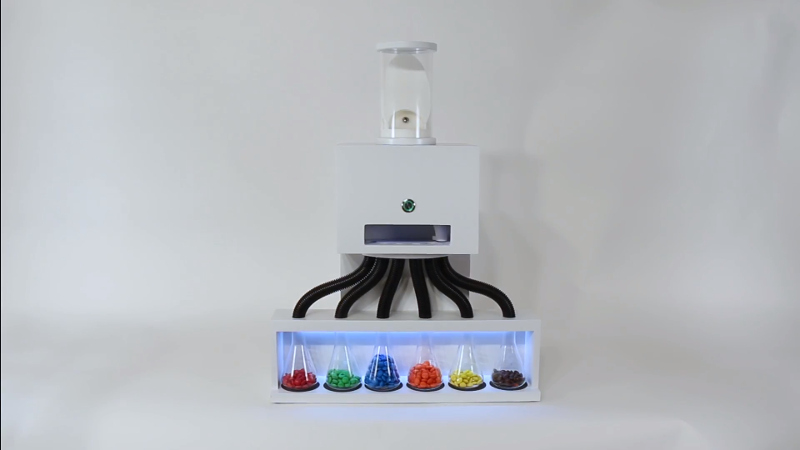Sorting M&Ms is really only a major concern if you happen to be working on a Van Halen tour, but it’s a fun exercise nonetheless. It’s for this reason we see plenty of sorting projects come our way, varying from the breadboard and cardboard variety, all the way up to final university projects. Today, [Karl] has blessed us with their sculptural-grade offering, and the attention to detail is stunning.
The project has been in gestation in [Karl]’s mind, on and off, for 10 years or so. The big problem centered around reliably separating out one M&M at a time from a hopper of many. From time to time, [Karl] would speak with other builders using similar techniques to his failed experiments, who often reported that the secret to their machine’s reliability was… careful video editing. It was only when a parts sorter flashed across the Hackaday feed that [Karl] found the mechanism that would work to make his project a reality.
Now that the individual candies could readily be separated and fed through a machine, the rest of the project came together quickly. A color sensor was combined with servos and a stepper motor to duct M&Ms into separate flasks.
The real value of this build, however, is in the overall attention paid to the aesthetics of the final product. The device was built to be a kinetic sculpture, able to run reliably with the minimum of attention at the behest of even an untrained user. By carefully optimising the mechanisms inside and building an attractive enclosure, [Karl] has developed something we’d be proud to show off in a living room.
















s/seperate/separate
+1
This is HaD, it’s been the trade mark since it’s inception.
I belive you mean trade-mark.
“Trademark” is one word.
It’s a trade-off, Mark!
Or a tirade of Mark…
There is a rat in separate.
Fixed. Thanks.
Now on to a flush button, which empties all the flasks at once and puts the candies back into the hopper, just to start over sorting them again.
A totally useless but wonderful machine!
I want a TH resistor sorter. I know that people have tried with optical and also measurement approaches, but it would be cool to be able to take a pile of ‘floor resistors’ and sort them into bins by value.
Shake them into an upright position. Feed them through with a rubber cog between four metal strips.
Measure the resistance as they pass.
Then drop them in a rotary wheel dispenser.
Maybe sort by sticking into graph paper on polystyrene with a plotter. I’d like to see that.
“Shake them into an upright position. Feed them through with a rubber cog between four metal strips.
Measure the resistance as they pass.
Then drop them ”
back on the floor.
Grinds them all up in one go and does chromatography… :D
The Brown M&M clause in Van Halen’s contracts was to be sure that their venue providers actually read through the provision contracts and provided the infrastructure needed to safely put on a show.
From David Lee Roth (quoted variously on the internet):
“Van Halen was the first band to take huge productions into tertiary, third-level markets. We’d pull up with nine eighteen-wheeler trucks, full of gear, where the standard was three trucks, max. And there were many, many technical errors — whether it was the girders couldn’t support the weight, or the flooring would sink in, or the doors weren’t big enough to move the gear through.”
“The contract rider read like a version of the Chinese Yellow Pages because there was so much equipment, and so many human beings to make it function. So just as a little test, in the technical aspect of the rider, it would say “Article 148: There will be fifteen amperage voltage sockets at twenty-foot spaces, evenly, providing nineteen amperes …” This kind of thing. And article number 126, in the middle of nowhere, was: `There will be no brown M&M’s in the backstage area, upon pain of forfeiture of the show, with full compensation.’ ”
“So, when I would walk backstage, if I saw a brown M&M in that bowl … well, line-check the entire production. Guaranteed you’re going to arrive at a technical error. They didn’t read the contract. Guaranteed you’d run into a problem. Sometimes it would threaten to just destroy the whole show. Something like, literally, life-threatening”.
This is an ingenious indicator, and I’ve found this sort of thing (an out of place clause or phrase in a contract or document – none of them mentioning brown M&Ms) to be very valuable over the years.
No!
David Lee Roth just does not like brown M&Ms, and will throw a hissy fit if he sees one.
That’s my story and I’m sticking to it!
*This* was exactly what I thought of when I read this article. +1
WTH?
The machine is full on the picture on the front page and then you click here and it’s empty!
Clickbait of the century!
M&Ms don’t stick around for long.